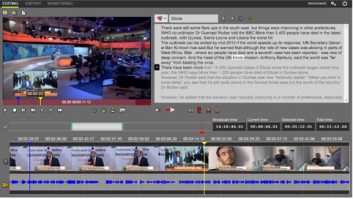
Chris Steele, managing director, Marquis Broadcast
Managing ‘cross platform’ workflows presents various challenges due to the many integration issues. Media needs to be found, edited and delivered and each stage of the process presents its own issues.
Ideally, editors need to be able to search, browse, select and bring media into edit, without copying, transcoding or re-wrapping. However, at the moment, not every edit system is able to handle every flavour of media. This situation is getting worse as new capture formats frequently appear.
Broadcasters appreciate these challenges and many are moving towards one type of storage, format and set of management tools. Yet, creating a mammoth single media storage and MAM presents its own issues as by its nature it is a fragile single point of failure. The bigger the media store, the more critical is the metadata search capability; there is no point having several petabytes of media online if you can’t find what you need.
The global nature of broadcasting today compounds this problem. Washington may want to edit something that has been created in Singapore. It might be stored on Avid but needs to be edited in Adobe Premiere Pro. With multi-storage locations and platforms how can media be stored without unnecessary duplication?
Storing and finding media is one issue, ensuring it is in a format ready for editing is another. Delivery can also present the same cross manufacturer integration issues but in reverse. There will be a set of requirements for the delivered media and metadata. For example, delivery to a news system may need to be to a pre-created placeholder. Metadata needs to be sent to the MAM but metadata schemes are unique to each facility, making multi-location workflows complex.
Comprehensive solutions are only going to become available if manufacturers of the various systems and tools support all available media formats, and can exchange and preserve metadata and rich sequence information. For example: a sophisticated federated search – the ability to search across multiple storage platforms and MAMs – would not only allow you to find media in Singapore, but could let you know if someone else locally has recently moved it closer to you or into the format you require.
Such comprehensive solutions will require unprecedented collaboration between manufacturers, driven by considerable customer pressure. They will also have significant cost. Until then, point solutions will have to do.
Marquis has recently developed Edit Bridge, which enables the seamless integration of Adobe Premiere Pro and After Effects CC in an Avid Interplay environment. Edit Bridge makes it possible to edit Interplay content directly in Adobe Premiere Pro or After Effects.
Users can search Avid Interplay from within the Premiere or After Effects interface, view thumbnails, find media and select for editing. Content in the correct codec is streamed direct to Premiere or After Effects for immediate editing, while other content is copied and re-wrapped. Delivery of the completed story back to ISIS is achieved with Interplay ‘Check In’.
By taking care of the technical know-how, we enable editors to focus on the business of creativity.
Come and chat to us about our solutions at IBC2015.
2.A58







